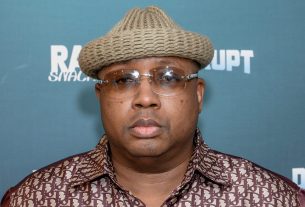Now, Dion said she won’t be able to go through with her European tour in February, which had already been rescheduled in April. The tour was originally scheduled for May to September this year.
“I have no choice but to concentrate on my health at this moment, and I have hope that I’m on the road to recovery,” Dion said. “This is my focus and I’m doing everything that I can to recuperate.”
SPS cannot be cured, but an assortment of treatments can help alleviate some symptoms.
“I always give 100% when I do my shows, but my condition is not allowing me to give you that right now,” Dion said. “I’m working hard with my sports medicine therapist every day to build back my strength and my ability to perform again. But I have to admit it’s been a struggle.”
“All I know is singing, it’s what I’ve done all my life,” Dion continued, “and it’s what I love to do the most.”
Tara Zier, founder and CEO of the Stiff Person Syndrome Research Foundation, who also has SPS, told BuzzFeed News that she had reached out to Dion on Instagram one month ago “to offer resources because her symptoms sounded all too familiar.”
Dion’s official diagnosis and announcement brought Zier to tears, she said: “It’s a mix of shock and really deep empathy. Listening to her talking about her kids supporting her, empathizing with how lonely it can feel and how hard it is when you can’t participate in what you love doing really resonates with me.”
Zier said Dion’s hope means everything. “When you’re facing an incurable disease, it can feel hopeless. But Céline will give thousands of patients hope. Maybe now people will take the disease seriously.”
She partly blames the disease’s “ridiculous name” for the “agonizing” amount of time it takes to get an SPS diagnosis: about seven years on average, Zier said. “People aren’t just stiff. It impacts vocal cords. Breathing. Walking. Going out in public. It’s impacting Céline’s life and every patient who suffers from SPS can relate to that.”
Because of the varying symptoms that accompany this disease, people are often misdiagnosed with multiple sclerosis, Parkinson’s disease, fibromyalgia, anxiety, or psychosomatic disorder — in other words “psychologically unwell,” Zier said.
But Zier is confident that people will start to take the disease more seriously because of Dion’s decision to be open about her diagnosis.
“Céline’s SPS diagnosis is going to wake people up. Today,” Zier said. “She is already using her beautiful voice to shine a bright light on an often-misdiagnosed but devastating disease.”
What are the symptoms of stiff-person syndrome?
The severity and progression of SPS vary from one person to another. Researchers consider the disease to be on a spectrum, sometimes involving just one area of the body like the torso or more of a widespread issue that affects the brain and spinal cord.
Symptoms usually develop over months or years, starting off as achy discomfort and stiffness in the legs or lower back that comes and goes, until eventually the pain becomes permanent and spreads to other parts of the body. Some people may develop a hunched or arched posture once the disease affects their spine.
Muscle spasms can occur randomly or following a variety of triggers, such as loud or unexpected noises like car horns, minor physical contact like a tap on the shoulder, cold temperatures, stress, emotional distress, and more.
These spasms can be severe, causing some people to fall and seriously injure themselves, or develop severe anxiety that keeps them from leaving their homes. They can occur anywhere on the body, most often the legs, but spasms in abdominal muscles, for example, can trick people into thinking their stomach is full and lead to unintended weight loss. Similarly, spasms in the chest may require some people to seek emergency respiratory support to breathe.
Spasms tend to last several minutes, but can go on for hours. As a result, some people with SPS need to use canes, walkers, or wheelchairs.
Most of the time, other neurological symptoms don’t occur.
What causes stiff-person syndrome?
There are still many unknowns about what causes SPS, but researchers believe it has something to do with the immune system attacking healthy tissue for unknown reasons.
Most people with SPS lack gamma-aminobutyric acid, or GABA, a neurotransmitter that helps control muscle movement. So some experts speculate that the immune system attacks certain nerve cells involved in the production of GABA.
Who’s more likely to develop stiff-person syndrome?
There aren’t clear risk factors that make someone more likely to develop SPS, but twice as many women as men are diagnosed with the condition, according to the National Institutes of Health.
Symptoms typically become more obvious to people around 30 to 60 years of age, but children and older adults have been diagnosed with SPS.
SPS also appears to be associated with other autoimmune disorders, the most common one being type 1 diabetes. Some people with the disease may also develop thyroiditis (inflammation of the thyroid), vitiligo (patchy loss of skin color), pernicious anemia, and epilepsy.
What’s the treatment for stiff-person syndrome?
SPS can be diagnosed with a blood test, an EMG exam that measures electrical activity in muscles, and a lumbar puncture, a procedure in which a doctor uses a needle to collect fluid from your spinal canal.
Treatment for SPS is based on a person’s specific symptoms and can involve a variety of approaches, like medication and physical therapy.
Anticonvulsant drugs like vigabatrin, valproate, pregabalin, and gabapentin, as well as other anti-anxiety medications and muscle relaxants, have been shown to help alleviate some symptoms.
Intravenous immunoglobulin, or IVIG, has also shown some promise in clinical studies for the treatment of muscle stiffness and sensitivity to stimuli like noise and stress. However, IVIG has been associated with increased risks of stroke and heart attack.
If people suddenly stop taking their medication, severe and potentially life-threatening muscle spasms can occur.
Dion didn’t share details about her treatment plan, but she said her doctors and family are by her side.
“I want to thank you so much for your encouraging wishes of love and support on my social media. This means a lot to me,” Dion said in the video, while holding back tears. “Take care of yourselves. Be well. I love you guys so much and I really hope I can see you again really soon.”



